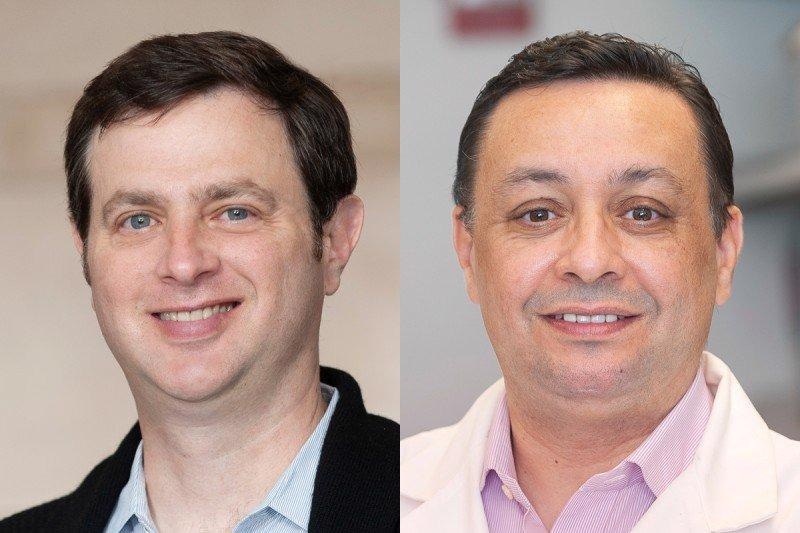Many cancers include genetic “hotspots,” or sections of DNA that are subject to mutation. For example, a mutation in the TP53 gene is found in more than 50% of all cancers, generally within a narrow DNA range.
 Computational oncologist Benjamin Greenbaum (left) and immunologist Taha Merghoub studied mutations in the gene TP53 to analyze what factors determine genetic hotspots. Image Credit: Memorial Sloan Kettering Cancer Center.
Computational oncologist Benjamin Greenbaum (left) and immunologist Taha Merghoub studied mutations in the gene TP53 to analyze what factors determine genetic hotspots. Image Credit: Memorial Sloan Kettering Cancer Center.
Hotspots have been linked to the development and spread of cancer, according to research. For example, the TP53 gene produces a protein that is essential for eliminating cells with genetic errors that might lead to cancer. When TP53 is mutated, precancerous cells have fewer defenses against uncontrollable growth.
Researchers have wondered why particular hotspots appear in a variety of cancers. Cancer cells appear to benefit from mutations in certain spots in terms of growth and survival. But scientists are not sure what causes hotspots in one DNA stretch of the same gene over another—or certain tumor-suppressing genes over others.
Different explanations have been out there about why you see these same hotspots come up across different tumor types. That’s always a good opportunity for computational or mathematical modeling to see if you can put all these pieces together in a consistent way.”
Benjamin Greenbaum, Computational Biologist, Memorial Sloan Kettering Cancer Center
Dr Greenbaum and MSK colleagues have found that TP53 mutations that promote cancer growth can also make a cell more visible to the immune system, leaving it exposed to attack. The research examines the interaction between these two factors and how the tension between them might result in hotspots.
The knowledge researchers acquired may help improve the effectiveness of cancer therapies, particularly immunotherapies.
Dr Greenbaum and David Hoyos of the Greenbaum Lab conducted the work, which was published in Nature on May 11th, 2022, in partnership with immunologists Jedd Wolchok and Taha Merghoub, as well as Roberta Zappasodi and Isabell Schultze of the Wolchok-Merghoub Laboratory. Vinod Balachandran, a physician-scientist, and Zachary Sethna, a physicist at the Balachandran Lab, were also in the group.
Cancer cells trade off between growth and invisibility
Their findings contradict earlier theories on hotspots, which held that escaping immune attacks was a separate aspect of cancer cells’ ability to survive and develop.
Dr Greenbaum adds, “We thought many hotspots would not be particularly visible to the immune system, but with this work, we are learning that might not be the case. The cancer cells have to make trade-offs between growth and invisibility. Sometimes, a feature that provides a strong fitness advantage [for growth] is what makes it easier for the immune system to see. These two features can be coupled together.”
The researchers chose TP53 because it has been extensively investigated, with its numerous mutations clearly defined. The researchers started by looking at how various mutations are spread across the gene. Researchers then created a mathematical model to show how these competing forces affect a cancer cell’s survival: mutations that boost growth and mutations that “hide” from immune detection.
One major point from their research is that invisibility is not everything. While some hotspots survive by evading immune identification, others encourage cancer development so vigorously that it compensates for being recognized by the immune system. When cells become cancerous and divide, they keep these hotspots because the growth advantage they bring is too valuable to throw away.
“It’s like an accelerator pressed to the floor, driving growth so strongly that it overpowers any brake put forth by the immune system,” Dr Merghoub notes.
The researchers also wondered if TP53 hotspots exist before cancer cells develop. Scientists examined dozens of papers that identified mutations in precancerous tissue and discovered the same hotspots, but with an unusual twist: the frequency ranking was changed.
More “pro-growth” hotspots and fewer “invisibility” hotspots were found in the cells. This shows that hotspots that provide a growth advantage gain precedence over those that avoid immune detection in the early stages of cancer formation.
It might be that in the early stage, the cancer cells haven’t derived much of an advantage by avoiding immune detection. The pressure from the immune system comes in a bit later.”
Benjamin Greenbaum, Computational Biologist, Memorial Sloan Kettering Cancer Center
Earlier intervention with immunotherapy
The discovery might pave the path for new immunotherapy applications. If the drugs are administered early enough, a hotspot that is easier to recognize may also be simpler to target with immune-stimulating drugs. The researchers are investigating further into their data to see if immune-based therapies may prevent cancer development in certain people at an early stage.
These breakthroughs, according to Dr Greenbaum, were made possible by collaborations between laboratory and clinical researchers, such as the Program in Computational Immuno-Oncology, which was recently established to link MSK’s Computational Oncology Service, headed by Sohrab Shah, and the Parker Institute for Cancer Immunotherapy, led by Dr Wolchok.
We have a unique program that really fosters collaboration between experts in computational oncology and immunotherapy. It’s a wonderful, productive relationship our lab has with Jedd and Taha’s, and that MSK has with other institutions. One of the senior authors, Marta Łuksza, is a longtime colleague at Mount Sinai, so it really is a product of a group effort.”
Benjamin Greenbaum, Computational Biologist, Memorial Sloan Kettering Cancer Center
Source:
Journal reference:
Hoyos, D., et al. (2022) Fundamental immune–oncogenicity trade-offs define driver mutation fitness. Nature. doi.org/10.1038/s41586-022-04696-z.